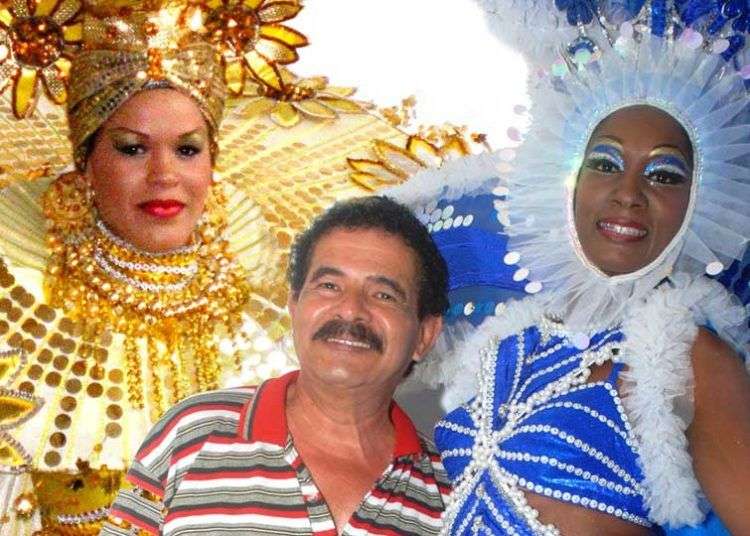He has designed signs, wedding suits, carnival customs, show customs, picture hats, caps, tiaras, scenography, floats. He has worked with cloth, threads, wood, metal, plastic, and leather, cardboard. He has left his imprint in theaters, weddings and passacaglias… but he is not done yet.
Right now, without using a single nail, he has raised the totems for the Santiago de Cuba carnival in its squares and main streets. Polychrome dolls, masks, devices hanging in the air, light, make up one of the most famous popular festivities in and out of Cuba.
“I have always said that the work of designers and producers in the show business is as hard as cutting down sugar cane. People say pieces are beautiful after they see it finished, but behind all that there are huge efforts”, stated José de Jesús Limia Castillo, better known as Pepin.
At Inclan warehouses, with his implacable aunt Noemi, he drank all in one go fantasy and by the age of 16 won his first recognition in the design of showcases. In order to achieve glamour and shine, he decided to cut out labels of Hatuey beer. The early 60’s were tough years.
Pepin broke the glass! This phrase spread all over the city, but it was just a matter of taking a closer look. He took the mannequin and put a street light in his hand. The design divided the object and a part of it was placed on the outside of the glass. That “scandal” curiously reaffirmed his success.
His fate seemed to take a turn years after when he joined the Orfeón Santiago. He had involved in music for fun with some friends, but he took it seriously under the direction of mythical Electo Silva and stayed with the choir for 17 years.
He can sing with confidence, you can ask for a song; those songs and those by the Proposicion Cuatro Quartet –which he founded by the late 80’s–, along with unforgettable Eva Griñán, Miguel Guilarte and José Aquiles.
No one was surprised when he majored from the José Joaquín Tejada Plastic Arts Academy; however, he did astonished many people in the sign contest for the carnival during 2003. Limia won the first, second and third awards. Synthesis and exuberance.
He was recognized in Bulgaria and Spain with other piece; there was nothing but applauses for him.
He started competing with himself in the carnivals of his home city. He was in charge of the design of the krewes of La Textilera and La Placita. Just a few knew about that. The joy was enormous when the judges declared there was a match.
“I’m a colorist, I’m from Santiago. I liked a series of combinations because they looked good, it is something we have inside though school gives you arguments and supports your ideas.
“I have studied styles, epochs, Cuban culture, and in 50 years of work, I already have a small library. Every time you work on a sign, a krewe, anything, first you have to study it”.
No secrets
Scenographyelements and accessories for the wardrobe of the first Cabaret Tropicana Santiago (1991), for which he would become the general designer for over a decade, came from his home, at Reparto Sueño. Red, white and gold. Those colors paved the way for a float-show to the Carnaval Caribana in Toronto (1993), with dancers from Tropicana Santiago and the band Los Karachi.
The float was about a garden with giant orchids and every dancer represented a different flower. The team made up by Manolito García Caluff, Rodolfo Seoane and Limia, worked really hard. In the midst of technology, hosts looked in amazement how much they had done manually joining some pieces here and there.
The parade lasted all day long, going around the Ontario Lake. From 7:00 am to 7:00 pm. Nonstop. At some point, dancers had to pour some beer on her feet in order to be able to go on.
July. Santiago de Cuba. The carnival bursts. On the verge of celebrating his 69th birthday, next September 19, Pepin Limia still looks at you in the eyes when he speaks:
“I don’t like keeping secrets. I have learned the hard way and I share my knowledge with my students, which makes me continue improving myself. I have to thank two people that have been like my hands: Ercilia Renté and Joel Bauta.”
“I have had to work with whatever materials on the reach, to discover anything that can be of good use. I have never been able to sit and wait;I have devoted my life to turning shortages into art”.










